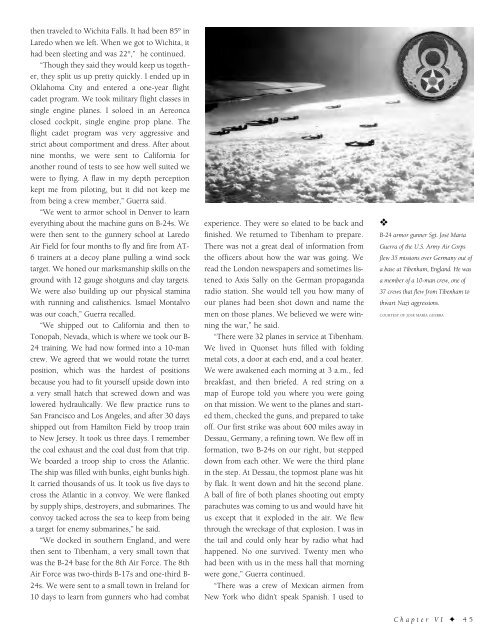Historic Laredo
An illustrated history of the city of Laredo and the Webb County area, paired with the histories of companies, families and organizations that make the region great.
An illustrated history of the city of Laredo and the Webb County area, paired with the histories of companies, families and organizations that make the region great.
Create successful ePaper yourself
Turn your PDF publications into a flip-book with our unique Google optimized e-Paper software.
then traveled to Wichita Falls. It had been 85° in<br />
<strong>Laredo</strong> when we left. When we got to Wichita, it<br />
had been sleeting and was 22°,” he continued.<br />
“Though they said they would keep us together,<br />
they split us up pretty quickly. I ended up in<br />
Oklahoma City and entered a one-year flight<br />
cadet program. We took military flight classes in<br />
single engine planes. I soloed in an Aereonca<br />
closed cockpit, single engine prop plane. The<br />
flight cadet program was very aggressive and<br />
strict about comportment and dress. After about<br />
nine months, we were sent to California for<br />
another round of tests to see how well suited we<br />
were to flying. A flaw in my depth perception<br />
kept me from piloting, but it did not keep me<br />
from being a crew member,” Guerra said.<br />
“We went to armor school in Denver to learn<br />
everything about the machine guns on B-24s. We<br />
were then sent to the gunnery school at <strong>Laredo</strong><br />
Air Field for four months to fly and fire from AT-<br />
6 trainers at a decoy plane pulling a wind sock<br />
target. We honed our marksmanship skills on the<br />
ground with 12 gauge shotguns and clay targets.<br />
We were also building up our physical stamina<br />
with running and calisthenics. Ismael Montalvo<br />
was our coach,” Guerra recalled.<br />
“We shipped out to California and then to<br />
Tonopah, Nevada, which is where we took our B-<br />
24 training. We had now formed into a 10-man<br />
crew. We agreed that we would rotate the turret<br />
position, which was the hardest of positions<br />
because you had to fit yourself upside down into<br />
a very small hatch that screwed down and was<br />
lowered hydraulically. We flew practice runs to<br />
San Francisco and Los Angeles, and after 30 days<br />
shipped out from Hamilton Field by troop train<br />
to New Jersey. It took us three days. I remember<br />
the coal exhaust and the coal dust from that trip.<br />
We boarded a troop ship to cross the Atlantic.<br />
The ship was filled with bunks, eight bunks high.<br />
It carried thousands of us. It took us five days to<br />
cross the Atlantic in a convoy. We were flanked<br />
by supply ships, destroyers, and submarines. The<br />
convoy tacked across the sea to keep from being<br />
a target for enemy submarines,” he said.<br />
“We docked in southern England, and were<br />
then sent to Tibenham, a very small town that<br />
was the B-24 base for the 8th Air Force. The 8th<br />
Air Force was two-thirds B-17s and one-third B-<br />
24s. We were sent to a small town in Ireland for<br />
10 days to learn from gunners who had combat<br />
experience. They were so elated to be back and<br />
finished. We returned to Tibenham to prepare.<br />
There was not a great deal of information from<br />
the officers about how the war was going. We<br />
read the London newspapers and sometimes listened<br />
to Axis Sally on the German propaganda<br />
radio station. She would tell you how many of<br />
our planes had been shot down and name the<br />
men on those planes. We believed we were winning<br />
the war,” he said.<br />
“There were 32 planes in service at Tibenham.<br />
We lived in Quonset huts filled with folding<br />
metal cots, a door at each end, and a coal heater.<br />
We were awakened each morning at 3 a.m., fed<br />
breakfast, and then briefed. A red string on a<br />
map of Europe told you where you were going<br />
on that mission. We went to the planes and started<br />
them, checked the guns, and prepared to take<br />
off. Our first strike was about 600 miles away in<br />
Dessau, Germany, a refining town. We flew off in<br />
formation, two B-24s on our right, but stepped<br />
down from each other. We were the third plane<br />
in the step. At Dessau, the topmost plane was hit<br />
by flak. It went down and hit the second plane.<br />
A ball of fire of both planes shooting out empty<br />
parachutes was coming to us and would have hit<br />
us except that it exploded in the air. We flew<br />
through the wreckage of that explosion. I was in<br />
the tail and could only hear by radio what had<br />
happened. No one survived. Twenty men who<br />
had been with us in the mess hall that morning<br />
were gone,” Guerra continued.<br />
“There was a crew of Mexican airmen from<br />
New York who didn’t speak Spanish. I used to<br />
❖<br />
B-24 armor gunner Sgt. José María<br />
Guerra of the U.S. Army Air Corps<br />
flew 35 missions over Germany out of<br />
a base at Tibenham, England. He was<br />
a member of a 10-man crew, one of<br />
37 crews that flew from Tibenham to<br />
thwart Nazi aggressions.<br />
COURTESY OF JOSÉ MARÍA GUERRA<br />
Chapter VI ✦ 45
















